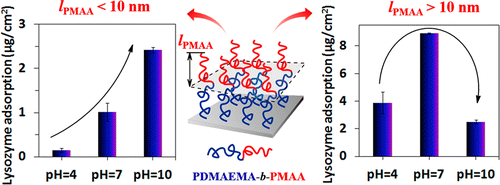Control of Lysozyme Adsorption by pH on Surfaces Modified with Polyampholyte Brushes
Hongyan Lei , Mengmeng Wang , Zengchao Tang , Yafei Luan , Wei Liu , Bo Song *(宋波), and Hong Chen *(陈红)
Jiangsu Key Laboratory of Advanced Functional Polymer Design and Application, Department of Polymer Science and Engineering, College of Chemistry, Chemical Engineering and Materials Science, Soochow University, Suzhou 215123, PR China
Langmuir 2014, 30, 501–508.
The adsorption of lysozyme is difficult to control by pH because of the relatively high isoelectric point of this protein (11.1). In this article, we demonstrate good control of lysozyme adsorption by pH in the range of 4–10 on silicon surfaces through modification with poly(2-(dimethylamino ethyl) methacrylate)-block-poly(methacrylic acid) (PDMAEMA-b-PMAA) diblock copolymer brushes. We show that the thickness of the outer PMAA block (lPMAA) is critical to the adsorption. When lPMAA was less than 10 nm, adsorption increased with increasing pH, and the difference in adsorption between high and low pH increased with lPMAA. The ratio of adsorption at pH 10 and pH 4 reached values as high as 16.4. When lPMAA was more than 10 nm, the adsorption tendency on the PDMAEMA-b-PMAA diblock copolymer brushes was similar to that on PMAA homopolymer brushes. These results indicate that the combination of PDMAEMA and PMAA gives adsorption behavior reflecting the properties of both polymers. However, if the outer PMAA block is thicker than a critical value, then the protein-resistant effect of the inner PDMAEMA block is screened.

链接: //pubs.acs.org/doi/abs/10.1021/la403781s